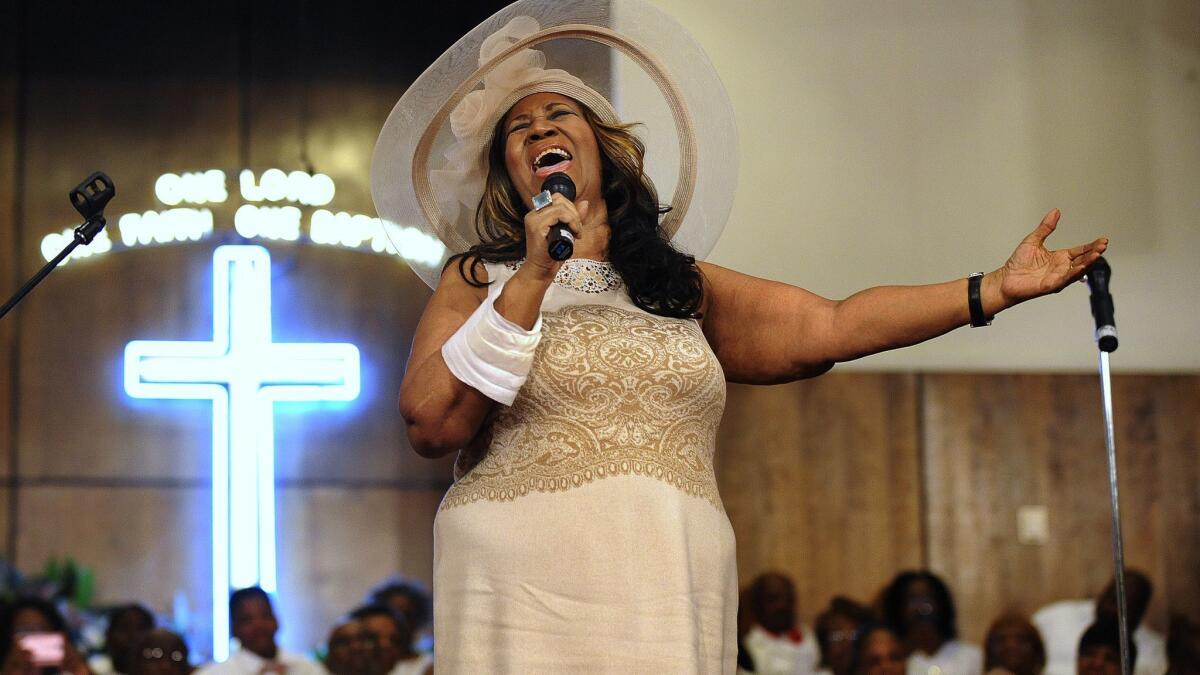Recorded in Watts, Aretha Franklin’s live album ‘Amazing Grace’ made gospel history on two days in 1972

- Share via
In early 1972, Aretha Franklin arrived at the New Temple Missionary Baptist Church in Watts for a pair of performances with the backing of the Rev. James Cleveland and the Southern California Community Choir. Recorded by Atlantic Records engineers and documented on film by Sydney Pollack, the music was released less than six months later as the double album “Amazing Grace.”
One of the great gospel records, it captures Franklin at the peak of her powers and in her comfort zone. She’s in church. Her father, the Rev. C.L. Franklin, is there. Guiding production is her friend Cleveland and his choir. In the audience is another former teacher, the great gospel singer Clara Ward, as well as two members of the Rolling Stones (Mick Jagger and Charlie Watts). And surrounding them all are raucous, praise-ready congregants eager to clap, shout and scream along.
Within a few weeks of its summer ’72 release, that energy had propelled Franklin’s gospel-filled revelry into the top 10 on Billboard’s album charts, where it battled for No. 1 alongside records by Elton John, Bill Withers and Donny Osmond. “Amazing Grace” remains Franklin’s bestselling album, and it’s one of the most commercially successful gospel records of all time.
It also anointed Franklin, then just shy of 30, as “a public witness in the most spiritual sense of the word,” says Daniel Walker, a professor at El Camino College and founder of the Gospel Music History Archive at USC. “The person who cries out. The person who says, ‘Listen!’ The person who says, ‘This is happening!’ The person who says, ‘Wake up!’”
Franklin would serve as an unofficial American spiritual witness for the rest of her life, standing aside three presidents during inaugurations — she appeared to sing not only for her life but also in service of the republic. Decades after it first hit the record racks, “Amazing Grace,” Walker says, “captures the church experience, it captures the black experience, it captures the human experience.”

When Franklin entered the sanctuary at New Temple in ’72, her future as a bankable star was hardly assured, especially through a live gospel record. She’d had hits starting in 1967, when, after recording early middle-of-the-road gospel and pop albums for Columbia, she signed with the soul label Atlantic Records, where she added drums and a band at the Muscle Shoals Sound Studio in northern Alabama and definitively married the spiritual and the secular.
She, Cleveland’s band and the Southern California Community Choir eased into Marvin Gaye’s ‘Wholy Holy,” and as anyone who’s listened to “Amazing Grace” understands, the answer to commercial concerns was within the room and had nothing to do with sales or spins or meeting anyone’s expectations. Whether sitting behind the piano or standing at the pulpit, Aretha poured forth biblical drama through tonal precision, wails of pitch-perfect glory interrupted by sublime moments of grace. Her hums express the pain of the ages, her pauses dense with fervor.
Granted, she learned from the best, says Walker. Describing Aretha’s father as “the most important black preacher in America” at the time, the elder Franklin was “a master at channeling the spirit and being able to create a public witness, to listen and feel the crowd and to take everything they have, take all their pain and aspirations and then give something even more aspirational,” Walker says.
Calling her ascent “a progression,” Walker noted Aretha Franklin’s reticence to go full gospel diva on her early work and contrasted that with the freedom she was given by Atlantic Records’ Jerry Wexler.
Once comfortable, she began to channel like her dad did, Walker says, “not in the gospel world but in the secular world,” where “you get to take every woman’s pain, you know? You get to take everybody’s heartache, you get to take the collective struggle of black people trying to make it in America — you get to take all that stuff, mix it up and be true to it, but also elevate it to another place.”
Across “Amazing Grace,” Franklin elevates, jumping from Old Testament to New, from contemporary song craft (tidbits of Carole King’s “You’ve Got a Friend”) to old spirituals. She and the choir convey the biblical story of Mary, Martha and Lazarus on “Mary Don’t You Weep,” elsewhere imagining an afterlife “in the land where we’ll never grow old,” singing of rocky roads and “the sweet silver song of the lark” and pathways that lead to the promised land, told not just through lyrics but also phrasing, feats of vocal gymnastics and what seems like her infinitely inexhaustible voice.
Across the 14 tracks on the original double album, epiphanies abound, but to fully appreciate the energy, a recently issued 27-song version offers a more dynamic experience.
The most complete picture, however, remains unseen. As part of the initial project, the late filmmaker and actor Pollack was commissioned by Atlantic and Warner Bros. to film the concerts for a documentary. Because of rights issues, the footage languished in the vaults for decades. In 2015, the finished movie was slated to screen at the 2015 Toronto Film Festival. Franklin, however, successfully filed a cease-and-desist order to prevent its showing.
That will likely change with Franklin’s death, and if so, a crucial Watts document will find its place in the bigger story. What they’ll see and hear, Walker says, is an artist in her element, expressing grace through her “ability to take the commoners in the world and to elevate their experience, to say to the world that their experience is worth listening to. ‘You need to listen — they’re telling you something.’”
For tips, records, snapshots and stories on Los Angeles music culture, follow Randall Roberts on Twitter and Instagram: @liledit. Email: randall.roberts@latimes.com.
More to Read
The biggest entertainment stories
Get our big stories about Hollywood, film, television, music, arts, culture and more right in your inbox as soon as they publish.
You may occasionally receive promotional content from the Los Angeles Times.











